
The Walbrook is a subterranean river in London. It gives its name to the Walbrook City ward and to a nearby street. It played an important role in the Roman settlement of Londinium.

The Walbrook is a subterranean river in London. It gives its name to the Walbrook City ward and to a nearby street. It played an important role in the Roman settlement of Londinium.
The usual interpretation is that the brook's name comes from weala broc meaning "brook of the foreigners" (usually taken to mean the native Britons, who were also referred to as the Welsh). [1] [2] This suggests that there was a British speaking quarter in the city in the Anglo-Saxon period, and this possibility has been linked to the division of the city by the Walbrook, with claims that the Britons lived on Cornhill to the east, while the Saxons lived on Ludgate Hill to the west. [3]
Another theory is that it was so named because it ran through or under the London Wall.
Geoffrey of Monmouth linked it to the phenomena of the Walbrook Skulls (below); recounting, or inventing an explanation where the name Gallobroc [4] derived from the name of a vanquished Roman leader called Livius Gallus.
The main branch flowing from the parish of Shoreditch was known (above the Wall) as the Deepditch, [5] Flood Ditch or just The Ditch.
The Walbrook divided the city into two hills: Ludgate Hill to the west and Cornhill to the east. [6]

It is thought that in the Anglo-Saxon period there may have been two Stallerships in the City, one for the land west of the river, and one for the east. Even beyond the walls, the river separated landholdings, with the Soke of Cripplegate to the west and the Soke of Bishopsgate to the east. By the 11th century, the two halves of the City had a distinct economy, character, customs and regulations. [7] The western side was more populous and prosperous, it had the cathedral, the royal palace (which later moved to Westminster) and its large market, Westcheap, was focussed on land-based trade. The east was poorer and more sparsely settled; its smaller market, Eastcheap, was sited near the river to allow it to specialise in seaborne trade. [8]
The division of the City into two parts persisted, in a less fundamental way, even to the time of John Stow, writing in 1603. [9]
It has been suggested that the probable derivation of the name Walbrook, river of foreigners (i.e. the native Britons), meant that there was a part of the city inhabited by native Britons (also known as Welsh), and this is assumed to be the eastern side on Cornhill, with the Saxons based on the higher status western Ludgate Hill.
London's defensive wall seems to have had an unintended impact on the river, acting like a dam to impede the flow of the river and create the marshy conditions which characterised the open space at Moorfields. [10] The wall's surrounding ditch may have diverted some of the water that would otherwise have gone through the City.
In 1838 construction workers building a new sewer under Blomfield Street, on the course of the Walbrook, discovered very large numbers of human skulls, [11] though very few other bones were present.
" An immense number of human skulls were found throughout this street" (ie Blomfield Street)
Since that time, around 300 further heads have been found in the bed of the river, generally in the vicinity of the initial discovery. It is believed that the number of heads destroyed by development, or awaiting discovery, may be in the order of many thousands. [12]
Writing around 1136, Geoffrey of Monmouth seemed to be aware of the presence of the remarkable number of skulls on the riverbed. His History of the Kings of Britain explained their origin as resulting from a massacre occurring during a Roman civil war, the Carausian Revolt of AD 286–296. In Geoffrey's account, a Roman legion under Livius Gallus, besieged in London, agrees to surrender to the forces of Julius Asclepiodotus on condition they are given safe passage out of Britain. Asclepiodotus is happy to grant this, but his allies the Venedoti moved on the captives, beheading them all in a single day. Geoffrey wrote that the river was afterwards named after Livius Gallus, the leader of the beheaded Romans, as Nantgallum in Welsh (the language of the native Britons), or in the Saxon English as Galobroc, from which Walbrook was derived. [4] However, Geoffrey's History is unreliable, and other theories have been proposed.
Some historians consider these skulls to be a result of the rebellion of Boudica. [13] More recently, the skulls have been dated mostly to the early 2nd century AD, and it has again been suggested that the skulls are the consequence of an anti-Roman rebellion in the 120s when London suffered a second major fire often called the Hadrianic fire. [12] The three martial explanations may link to the proposition, made by archaeologists, that some of the skulls may have represented ritual deposits of heads related to the Celtic cult of the head.
Archaeological excavations across this area in the late 20th and early 21st centuries (two examples are Finsbury Circus [14] and Liverpool Street [15] ) revealed a Roman burial ground which included graves scoured by the River Walbrook, and it was suggested that skulls might come from this. Other factors should also be considered here: the 'heads' or 'skulls' which have been recovered were actually crania (ie only the main/top part of the skulls - the accompanying jaw bones, which would have provided vital evidence for beheadings, execution or indeed massacre, were missing); human skulls are profoundly identifiable as being human and are more likely to have been spotted and collected during construction work - every single controlled archaeological excavation in this area has also uncovered other human bones, creating less of a bias towards 'skulls'; the crania recovered recently at Liverpool Street had a wide date range and therefore could not have amassed as the result of a single event (the 2nd-century bias noted above probably simply reflects the size of Roman London's population).
The vast numbers of crania found across the Walbrook valley suggest that, in essence, there were probably several different factors at play. Some individuals may indeed have experienced a violent end. The majority of the crania, however, were likely to have been displaced from their nearby graves by a combination of gravel extraction (to enable a 2nd-century expansion to Londinium which required large amounts of gravel for new roads, yards and thresholds) and occasional flooding by the Walbrook itself. Roman gravel-extraction workers, in a similar way to 19th-century construction workers, may have created an unintentional bias in, respectively, reverential crania reburial and crania collection and it is that which has emerged to help to create such an intriguing phenomenon.
The Walbrook had many small tributaries and the course of the various branches are ill-mapped and ill-understood, particularly in the upper reaches above London's Wall. Each new excavation in the area brings a refined understanding. [16]
The routes of the various branches may have changed over time, further complicating the limited understanding of the river’s history. These changes in course may have been due to natural changes and human intervention.
Modern maps of London in the Roman period show the Walbrook as having many tributaries. Roman London - a New Map and Guide [17] shows six branches. Most of these branches are to the West of the main eastern stream.
The river appears to have had a main eastern branch which ran from Hoxton, in the parish of Shoreditch, and one or more others flowing from Finsbury to the west. The picture is unclear, but both of these branches may have had ultimate sources as far north as Islington. [18]
The main branch of the stream, entering the city along the line of Blomfield Street, was known as Deepditch. [19] This main stream, and one or more of the western tributaries appear to have met in Moorfields, north of the City Wall. The river flowed south down what is now Blomfield Street, to the east of Finsbury Circus.
Just to the north of wall, the main branch (Deepditch) formed the boundary of the city wards of Coleman Street to the west, and Bishopsgate Without to the east. [19]
It then entered the walled area of the City just west of All Hallows-on-the-Wall Church. [20]
The brook flowed southward through the centre of the walled city, bringing a supply of fresh water whilst carrying waste away to the River Thames, at Dowgate; it effectively divided the settlement in two.
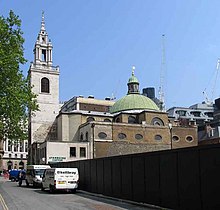
Stow in the 16th century suggested there was a branch, called the Langbourne (see Langbourne Ward) to the east, rising at St Katherine Coleman and running SW along Fenchurch Street (making this area 'fenny'), along Lombard Street, into Sherbourne Lane and presumably into the Walbrook. [21] Later scholars have been doubtful. Ralph Merrifield reported a stream flowing SW through the area that would later be the Roman Forum, which would have flown into this putative stream in Lombard Street. The main mentioned at the top of this section[ clarification needed ] reports another stream called the 'Lorteburn' flowing directly into the Thames; perhaps there has been confusion between these various streams.[ Still no mention of Islington. ]
It emerged just to the west of the present-day Cannon Street Railway Bridge. During Roman times it was also used for transport, with the limit of navigation some 200 m from the Thames, where the Bucklersbury building now stands. It was there the Romans built a port and temple to Mithras on the east bank of the stream. [22] The temple was found and later excavated during rebuilding work after World War II. The Roman Governor's palace was found further down the east bank of the stream, near its entry into the Thames.
In the 15th century the monasteries of Charterhouse and St Bartholomews diverted the headwaters of the Walbrook to their sites in the River Fleet catchment. It has been suggested [18] that this caused a significant reduction in the flow of the Walbrook.
When the church of St Margaret Lothbury was rebuilt in 1440, the Lord Mayor Robert Large paid for the lower Walbrook to be covered over. By the time of the first maps of the area, the "copperplate" map of the 1550s and the derivative "Woodcut" map of c.1561, the whole Walbrook within the city walls was culverted. John Stow, the historian of London, wrote about the Walbrook in 1598, saying that the watercourse, having several bridges, was afterwards vaulted over with brick and paved level with the streets and lanes where it passed and that houses had been built so that the stream was hidden as it is now. [6]
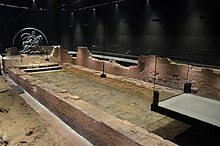
The construction of the massive infrastructure of the London sewerage system, with five main sewers, incorporated many existing culverts, storm sewers, and sluices. This included the culverted Walbrook, which by 1860 had been linked into a network of 82 miles (132 km) of new sewerage lines, channelled to the Northern Low Level Sewer at a point near the Bank of England. Many small leaks stream into the rounded sewer for much of the year when the water table is high enough. [23] On 18 June 1999, during the "Carnival Against Capitalism", timed to coincide with the 25th G8 summit, fire hydrants were opened along the route of the Walbrook by Reclaim the Streets, symbolically releasing the river to "reclaim the street" from the "capitalist forces" of city growth which had subsumed it. [24]

The City of London, widely referred to simply as the City, is a city, ceremonial county and local government district that contains the ancient centre, and constitutes, alongside Canary Wharf, the primary central business district (CBD) of London and one of the leading financial centres of the world. It constituted most of London from its settlement by the Romans in the 1st century AD to the Middle Ages, but the modern area referred to as London has since grown far beyond the City of London boundary. The City is now only a small part of the metropolis of Greater London, though it remains a notable part of central London. Administratively, the City of London is not one of the London boroughs, a status reserved for the other 32 districts. It is also a separate ceremonial county, being an enclave surrounded by Greater London, and is the smallest ceremonial county in England.
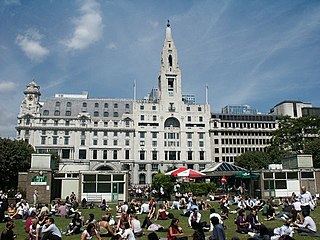
Finsbury is a district of Central London, forming the southeastern part of the London Borough of Islington. It borders the City of London.
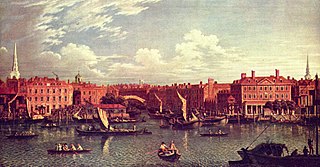
The River Fleet is the largest of London's subterranean rivers, all of which today contain foul water for treatment. It has been used as a sewer since the development of Joseph Bazalgette's London sewer system in the mid-19th century with the water being treated at Beckton Sewage Treatment Works. Its headwaters are two streams on Hampstead Heath, each of which was dammed into a series of ponds—the Hampstead Ponds and the Highgate Ponds—in the 18th century. At the southern edge of Hampstead Heath these descend underground as sewers and join in Camden Town. The waters flow 4 miles (6 km) from the ponds.

Watling Street is a historic route in England that crosses the River Thames at London and which was used in Classical Antiquity, Late Antiquity, and throughout the Middle Ages. It was used by the ancient Britons and paved as one of the main Roman roads in Britannia. The route linked Dover and London in the southeast, and continued northwest via St Albans to Wroxeter. The line of the road was later the southwestern border of the Danelaw with Wessex and Mercia, and Watling Street was numbered as one of the major highways of medieval England.
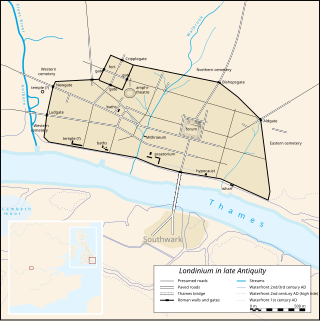
Londinium, also known as Roman London, was the capital of Roman Britain during most of the period of Roman rule. Most twenty-first century historians think that it was originally a settlement established shortly after the Claudian invasion of Britain, on the current site of the City of London around 47–50 AD, but some defend an older view that the city originated in a defensive enclosure constructed during the Claudian invasion in 43 AD. Its earliest securely-dated structure is a timber drain of 47 AD. It sat at a key ford at the River Thames which turned the city into a road nexus and major port, serving as a major commercial centre in Roman Britain until its abandonment during the 5th century.
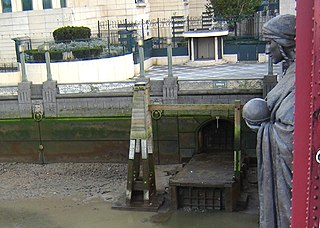
The River Effra is a former set of streams in south London, England, culverted and used mainly for storm sewerage. It had been a tributary of the Thames. Its catchment waters, where not drained to aquifer soakaways and surface water drains, have been incorporated into 1850s-built combined sewer sectors, devised by Sir Joseph Bazalgette. One drains Peckham, the other Brixton, then intended to flow towards Peckham. These generally flow east to be treated at Crossness.

Bishopsgate was one of the eastern gates in London's former defensive wall. The gate's name is traditionally attributed to Earconwald, who was Bishop of London in the 7th century. It was first built in Roman times and marked the beginning of Ermine Street, the ancient road running from London to York (Eboracum). The gate was rebuilt twice in the 15th and 18th centuries, but was permanently demolished in 1760.

The London Wall is a defensive wall first built by the Romans around the strategically important port town of Londinium in c. AD 200, as well as the name of a modern street in the City of London, England.

The London Mithraeum, also known as the Temple of Mithras, Walbrook, is a Roman Mithraeum that was discovered in Walbrook, a street in the City of London, during a building's construction in 1954. The entire site was relocated to permit continued construction and this temple of the mystery god Mithras became perhaps the most famous 20th-century Roman discovery in London.

London Stone is a historic landmark housed at 111 Cannon Street in the City of London. It is an irregular block of oolitic limestone measuring 53 × 43 × 30 cm, the remnant of a once much larger object that had stood for many centuries on the south side of the street.
Moorgate was one of the City of London, England's northern gates in its defensive wall, the last to be built. The gate took its name from the Moorfields, an area of marshy land that lay immediately north of the wall.

Moorfields was an open space, partly in the City of London, lying adjacent to – and outside – its northern wall, near the eponymous Moorgate. It was known for its marshy conditions, the result of the defensive wall acting as a dam, impeding the flow of the River Walbrook and its tributaries.

The Westbourne or Kilburn is a culverted small River Thames tributary in London, rising in Hampstead and Brondesbury Park and which as a drain unites and flows southward through Kilburn and Bayswater to skirt underneath the east of Hyde Park's Serpentine lake then through central Chelsea under Sloane Square. It passes centrally under the south side of Royal Hospital Chelsea's Ranelagh Gardens before discharging into Inner London's old-fashioned, but grandiose combined sewer system, with exceptional discharges into the Inner London Tideway. Since the latter 19th century, the population of its catchment has risen further but to reduce the toll it places on the Beckton Sewage Treatment Works and related bills its narrow basin has been assisted by private soakaways, and public surface water drains. Its depression has been replaced with and adopted as a reliable route for a gravity combined sewer. The formation of the Serpentine relied on the water, a lake with a long, ornate footbridge and various activities associated, which today uses little-polluted water from a great depth.
The Lorteburn or Langbourne is a lost stream or river, which ran in the east of the City of London, arising near to Aldgate, flowing south near to the Tower of London, and discharging into the River Thames. The stream appears to have been covered over or dry by the early 14th century but its course has been discovered during archaeological digs in the area and the watershed can be traced in the street level contours of that part of the city as mapped by Kelsey in 1841. The stream gave its name to the Langbourn ward of the city. The river is seldom included on maps or lists of London's lost rivers, and its existence is denied by Nicholas Barton, in his 1962 book Lost Rivers of London, but in more recent work David Bentley argues for its existence.

The River Tyburn was a stream in London, England. Its main successor sewers emulate its main courses, but it resembled the Colne in its county of Middlesex in that it had many distributaries. It ran from South Hampstead, through Marylebone, Mayfair, St James's parish/district and Green Park to meet the tidal Thames at four sites, grouped into pairs. These pairs were near Whitehall Stairs, and by Thorney Street, between Millbank Tower and Thames House. Its much smaller cousin, the Tyburn Brook, was a tributary of the Westbourne and the next Thames tributary.

Stamford Brook was a tributary of the Tideway stretch of the River Thames in west London supplied by three headwaters. Historically used as an irrigation ditch or dyke, the network of small watercourses had four lower courses and mouths.

Langbourn is one of the 25 ancient wards of the City of London. It reputedly is named after a buried stream in the vicinity.

Coleman Street is one of the 25 ancient wards of the City of London, England, and lies on the City's northern boundary with the London Borough of Islington.
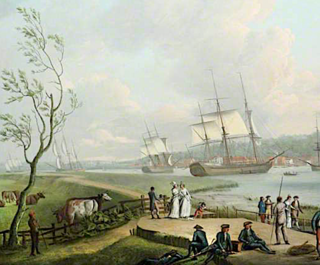
The Embanking of the tidal Thames is the historical process by which the lower River Thames, at one time a broad, shallow waterway winding through malarious marshlands, has been transformed by human intervention into a deep, narrow tidal canal flowing between solid artificial walls, and restrained by these at high tide. The Victorian civil engineering works in central London, usually called "the Embankment", are just a small part of the process.

Blomfield Street is a road in the City of London, close to Liverpool Street railway station. It was known as Broker Row, until 1860.